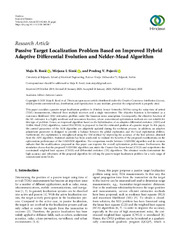| dc.description.abstract | This paper considers a passive target localization problem in Wireless Sensor Networks (WSNs) using the noisy time of arrival (TOA) measurements, obtained from multiple receivers and a single transmitter. The objective function is formulated as a maximum likelihood (ML) estimation problem under the Gaussian noise assumption. Consequently, the objective function of the ML estimator is a highly nonlinear and nonconvex function, where conventional optimization methods are not suitable for this type of problem. Hence, an improved algorithm based on the hybridization of an adaptive differential evolution (ADE) and Nelder-Mead (NM) algorithms, named HADENM, is proposed to find the estimated position of a passive target. In this paper, the control parameters of the ADE algorithm are adaptively updated during the evolution process. In addition, an adaptive adjustment parameter is designed to provide a balance between the global exploration and the local exploitation abilities. Furthermore, the exploitation is strengthened using the NM method by improving the accuracy of the best solution obtained from the ADE algorithm. Statistical analysis has been conducted, to evaluate the benefits of the proposed modifications on the optimization performance of the HADENM algorithm. The comparison results between HADENM algorithm and its versions indicate that the modifications proposed in this paper can improve the overall optimization performance. Furthermore, the simulation shows that the proposed HADENM algorithm can attain the Cramer-Rao lower bound (CRLB) and outperforms the constrained weighted least squares (CWLS) and differential evolution (DE) algorithms. The obtained results demonstrate the high accuracy and robustness of the proposed algorithm for solving the passive target localization problem for a wide range of measurement noise levels. | en |


